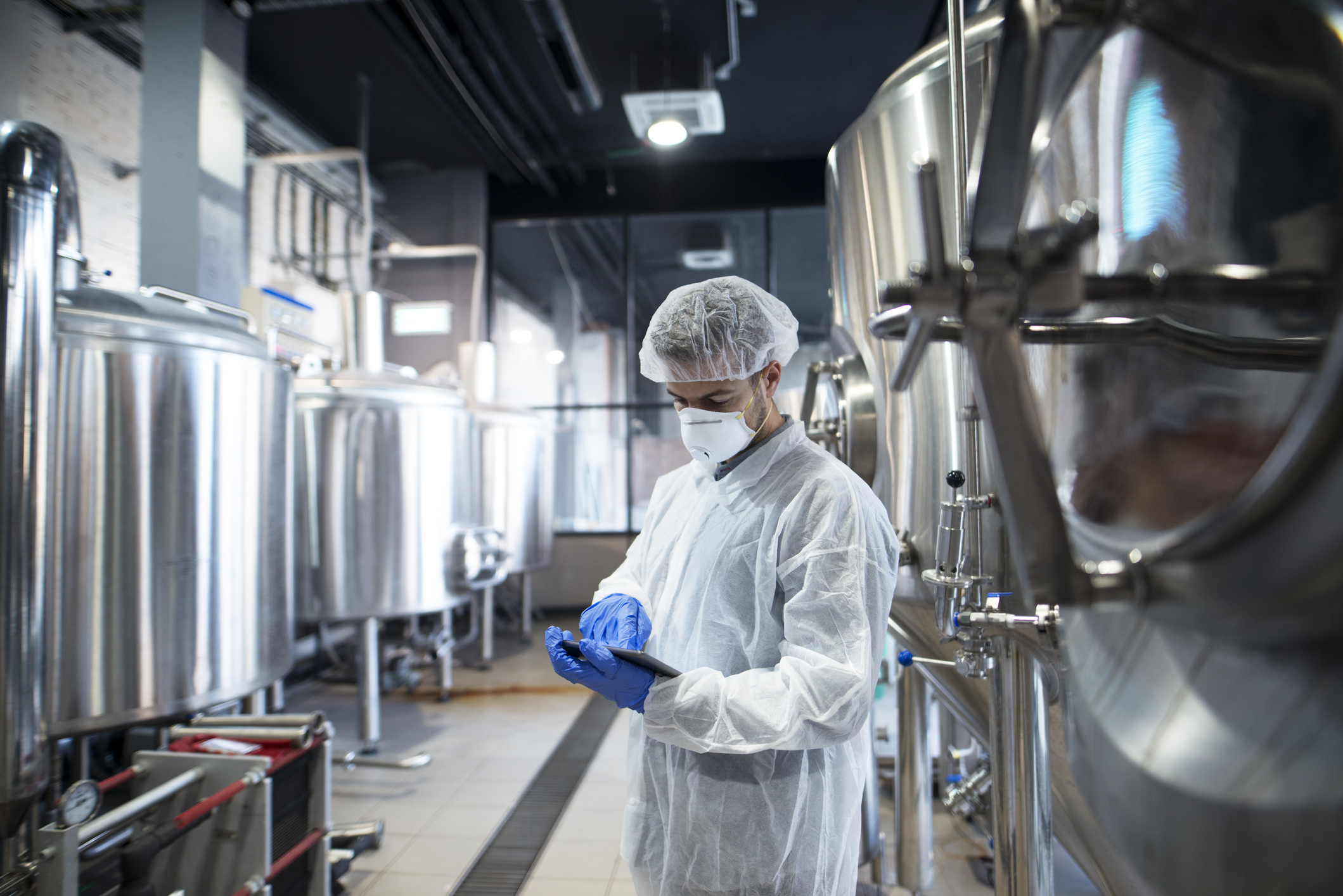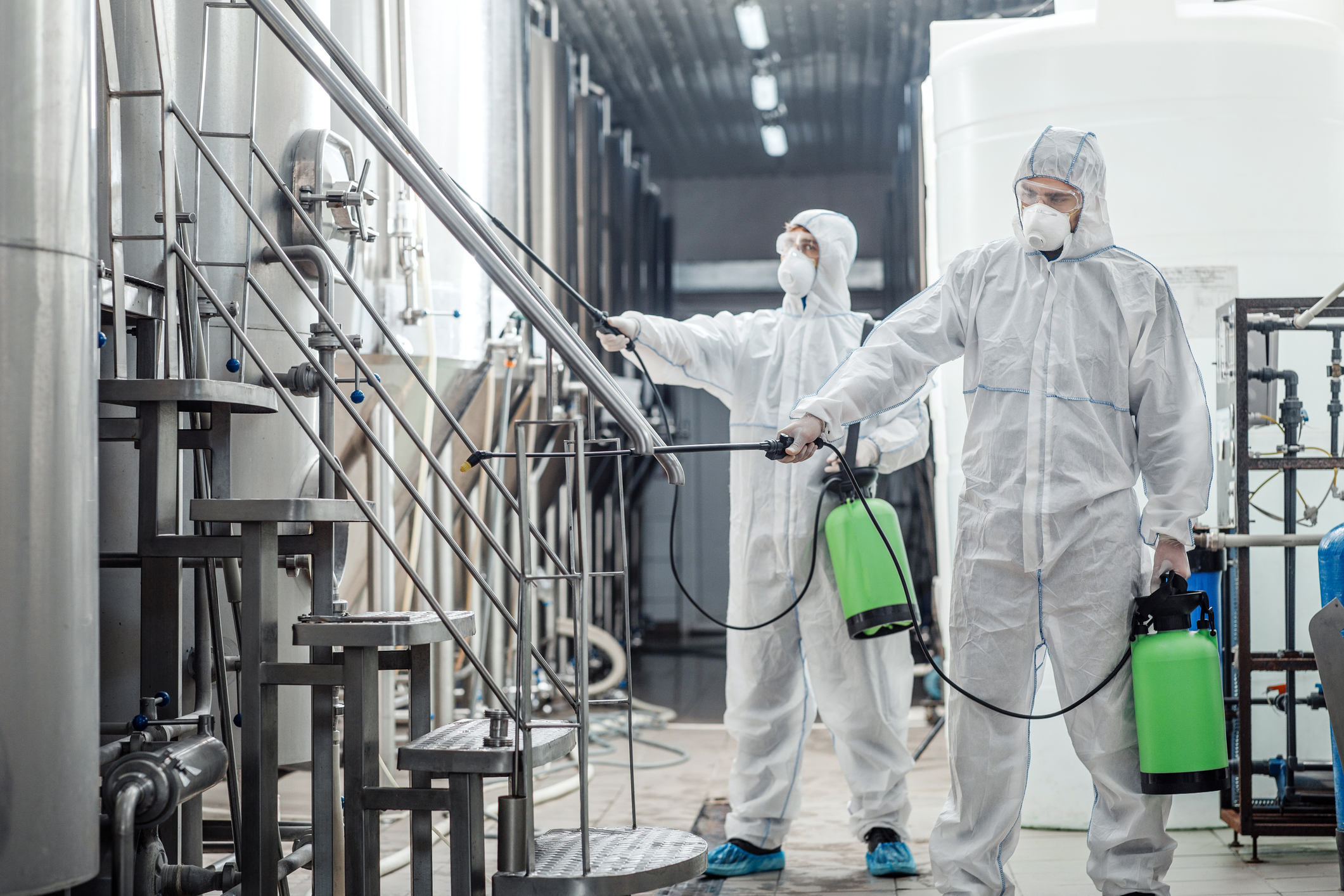Proper industrial hygiene starts before anything goes wrong — the first step to maintaining hygiene in the industrial setting involves anticipating areas with the potential to be hazardous and preparing accordingly. OSHA maintains a list of the most common places that cause workplace accidents to help you get started. Once an industrial sanitation expert knows where to look to identify concerns, they can recognize them more quickly and put your entire workforce on a path toward having a safer workplace.
One of the main priorities of any workplace is to keep its employees safe and healthy. But in practice, ensuring employee safety and health care can prove difficult. According to the U.S. Bureau of Labor Statistics (BLS), 5,250 workers died from workplace-related injuries in 2018, and 2.8 million nonfatal workplace injuries and illnesses occurred in the private sector alone.
Fortunately, proper industrial hygiene in the workplace can help. A robust industrial hygiene and chemical safety program helps reduce hazard levels in the workplace, and it gives employees the tools and protection they need to stay safe when they encounter hazards. In this guide, we’ll discuss how an industrial hygiene program works.


What Is Industrial Hygiene?
Industrial hygiene is a science focused on identifying, evaluating, and controlling hazardous workplace conditions to prevent employee illness and injury. It involves monitoring and analyzing hazard exposure, implementing engineering solutions, and enforcing workplace controls to maintain a safe and healthy work environment.
Industrial hygiene involves recognizing, evaluating and adjusting for workplace hazards to help keep employees safe and healthy. It often entails the use of workplace monitoring and analysis to determine the levels of industrial hygiene hazards exposure. It also requires engineering solutions and workplace controls to help minimize those hazards.
Industrial hygiene had its beginnings in antiquity, when Roman scholars documented the health risks to workers exposed to sulfur, lead and zinc. Over further centuries, governments began enacting legislation to address industrial hygiene, starting with England’s Chimney-Sweepers Act of 1788. The United States enacted important pieces of legislation like the Metal and Nonmetallic Mines Safety Act of 1966, the Federal Coal Mine Safety and Health Act of 1969 and the Occupational Safety and Health Act of 1970.
The Four Principles of Industrial Hygiene
An industrial hygiene program requires constant surveying to ensure the health and safety of everyone in the workplace. An industrial hygienist will follow these four steps in any evaluation to identify areas of concern and develop solutions to fix them.
Once the industrial hygienist takes note of the anticipated issues in a workplace, they can begin monitoring such areas for instances of danger. They may look at how your employees operate around chemicals and make sure everyone is wearing proper protective equipment. As they watch you operate in real time, they can identify situations that may require a closer look on their part.
If a hygienist recognizes something of concern in the workplace, their next step is to complete an in-depth analysis that measures quantifiable data about whether a situation is truly hazardous. For example, if they notice an area isn’t well-ventilated, they may complete an occupational exposure assessment that measures ventilation levels and determines whether airflow is at an acceptable level.
Once they recognize the risks, it’s up to the industrial hygienist to recommend solutions that restore health and safety matters to acceptable levels. They may recommend eliminating or substituting certain workflows, adjusting engineering controls or revising administrative practices to put things back in order and ensure they stay that way.
Importance of Industrial Hygiene
Industrial hygiene is essential because it helps protect employees from several types of injuries and illnesses, including:
- Nonfatal illnesses: Skin, lung and gastrointestinal diseases like anthrax are common occupational hazards in agricultural operations, and blood-borne illnesses like hepatitis B and C are common occupational hazards in medical settings and laboratories. Industrial hygiene can help prevent the transmission of these diseases and many others.
- Respiratory conditions: Respiratory conditions like chronic bronchitis, asbestosis and pneumonitis are common occupational hazards, especially in industries like mining where inhaling dust is common. Industrial hygiene can help by mandating the use of personal protective equipment (PPE) which provides respiratory protection and improves working conditions.
- Skin diseases: Skin diseases like dermatitis, eczema, rashes and blisters are common in industries where workers’ skin comes into contact with hazardous chemicals. Industrial hygiene can help by mandating PPE and offering guidelines about how chemicals are used, labeled and stored in the workplace.
- Poisoning: Poisoning can occur if workers accidentally ingest toxic chemicals like pesticides, herbicides, formaldehyde or cleaning agents. Workers might also absorb those chemicals through their skin. Industrial hygiene can help by mandating how poisons are used, labeled and stored.
- Hearing loss: Hearing loss can occur when employees are exposed to high-decibel sounds in environments like airports or at construction and mining sites where detonations occur. Industrial hygiene can help by mandating personal PPE, measuring hazards with sound level meters and offering guidelines about noise exposure in the workplace.
- Repetitive stress injuries: Repetitive stress injuries occur when employees perform the same motions many times throughout the workday. Industrial hygiene can help by offering guidelines about correct posture and lifting techniques and mandating breaks for employees engaged in repetitive tasks.
Economic Effects of Absenteeism
Industrial hygiene has benefits for employers as well. When employees miss work because of illness or injury, employers tend to suffer losses:
- Lost productivity: Absenteeism in the workplace leads to lost productivity. When employees are absent, they cannot do the same amount of work, and scrambling to cover shifts in one area may lead to staffing shortages in another. And even when employees return, they may be slower and less productive because they still don’t feel their best.
- Diminished morale: High numbers of injuries and illnesses in the workplace tend to put a damper on employee morale. Plus, decreased employee morale can lead to even further diminished productivity, as well as distractedness, which can result in a vicious cycle of injury.
- Lost profits: Studies show that absenteeism costs companies about $3,600 per year for each hourly worker and $2,650 each year for salaried employees. These costs include wages paid during sick leave, the high cost of replacement workers and the profit losses associated with reduced production.
Fortunately, proper industrial hygiene helps keep employees safe, healthy, present and productive.
What Does an Industrial Hygienist Do?
Role During Industrial Hygiene Consultation
Two essential roles of the industrial hygienist are identifying workplace hazards and helping workplaces control them:
1. Identification of Hazards or Stressors
The first step in an industrial hygienist’s job is to identify the hazards or stressors that put employees at risk.
They typically do this by performing a worksite assessment in which they evaluate a workplace, identify its hazards and stressors and work to figure out what needs to change to improve safety and health.
2. Elimination or Control Through Appropriate Measures
Once they have identified the hazards in a workplace, industrial hygienists can begin developing a plan for eliminating or controlling of those hazards. Though total elimination of the hazard is ideal, in many situations, they have to settle for partial control through the implementation of safety protocols. Industrial hygienists are often involved in the development of standards to protect workers, and they are often the people who set up the field enforcement protocols and procedures to ensure workplaces are implementing those standards and abiding by them.
Overview of Industrial Hygiene Hazards and Controls
According to certified industrial hygienists, industrial hygiene hazards — and the controls implemented to reduce them – generally take five different forms: environmental, chemical, biological, physical and ergonomic.
Environmental hazards include stressors like air contaminants. These may be either particulate contaminants or gas and vapor contaminants.
Some common particulate contaminants include the following:
- Aerosols: Though aerosols are classed as particulate contaminants, they are tiny liquid particles. Aerosols are a specific, exceptionally respirable kind of mist.
- Dust: Dust is the tiny solid particles that form through activities such as abrading, blasting, crushing, drilling and grinding.
- Fibers: Fibers are long thin, solid particles. They are several times bigger in length than in diameter.
- Fumes: Fumes form when a solid becomes volatilized — as by burning – and then the volatilized particles condense in the air. Most of the time, these solid particles react with the air to form oxides.
- Mists: Mists are finely separated liquids that hang suspended in the atmosphere. They form when activities such as atomizing, foaming or splashing disperse a liquid into fine particles or when substances condense from a vapor back into a liquid suspension.
- Gases: Examples of gas contaminants in the workplace include carbon monoxide, which is a common byproduct of the operation of internal combustion engines, as well as welding gases such as acetylene, nitrogen, helium and argon.
- Vapors: Vapors form when substances that exist in solid or liquid states under normal temperature and pressure conditions change into a gaseous form — that is, they evaporate. Cleaning substances, paints and solvents are particularly susceptible to vaporizing, especially when under pressure or at high heats.
Adequate ventilation and the use of proper PPE, such as respirators and face shields, are often effective controls for environmental hazards.
Hazardous chemical compounds can take the form of gases, liquids, solids, dust, mists, vapors and fumes. They have harmful effects when employees ingest, inhale or absorb them through their skin.
To help control chemical hazards, facilities that use them should maintain a safety data sheet (SDS) for each chemical. The SDS comes directly from the manufacturer or supplier and contains essential health-related and toxicological information. Each chemical should also have a label with information that matches the chemical’s safety data sheet.
Biological hazards include bacteria, viruses and fungi that can cause illnesses. Biological hazards are common in laboratory and medical facilities, as well as in agricultural and food-processing operations. Any industry in which employees may become exposed to human or animal bodily fluids poses a risk of biological contamination.
Proper personal hygiene — including hand-washing measures and the use of PPE — is essential to help control biological hazards. Adequate ventilation, waste disposal systems and isolation protocols in the case of highly infectious diseases are also crucial.
Physical hazards occur when workplaces experience excessive levels of physical disruptions like:
Heat exposure: Radiant heat exposure represents a hazard in environments like steel mills and other factories. Here, employees must often work near equipment and substances that give off extreme heat. Reflective shields and protective clothing and goggles can help control this hazard.
Noise: Noise levels in the workplace become hazardous when employees are exposed to significant decibel levels over an extended time. Facilities can reduce noise hazards by installing silencers, mufflers or baffles to reduce noise levels. They can also try enclosing noisy machinery, or they can custom-engineer their machinery for quiet operation. Ensuring that all equipment is in good repair and receives regular maintenance helps reduce the squealing and grinding noises associated with maintenance needs.
Radiation: Radiation hazards exist in workplaces that contain equipment like X-ray machines and lasers, as well as in the nuclear, defense, aviation and oil and gas industries. Protective shields help reduce the risk of radiation exposure. In some cases, limiting the time of exposure also helps reduce the risks. However, in some cases — as with lasers — even infinitesimal exposure can inflict lasting damage.
Vibration: Vibration poses a particular hazard in transportation, where the drivers of logging, mining and long-haul trucks, cement mixers and construction equipment must ride over vibrating engines all day. The vibration of heavy equipment in factories can also cause discomfort. Workplaces can install shock absorbers and suspension systems in vehicles, or they can mount heavy equipment on specific mounts to help reduce vibration.
Ergonomic hazards are the hazards associated with poor posture and task-performing techniques in the workplace. Repeated activities such as holding lifting, pushing, reaching and even walking can all pose ergonomic hazards because their motions stress the body, especially when performed incorrectly.
Activities such as working on high-speed assembly lines, performing repetitive motions and being subjected to vibrations or shocks can pose ergonomic risks. Even activities like focusing on a computer screen — or some other fixed space — can lead to eyestrain.
Workplaces can control ergonomic hazards in several ways:
Administrative practices: Administrators can help control ergonomic hazards by rotating employees among tasks. Rotation ensures that muscles do not become strained through the performance of a single repetitive task. They can also mandate breaks for employees every few hours.
Job site design: Facilities can design their job site with ergonomic best practices in mind. Office workstations should contain ergonomically correct, adjustable chairs and keyboards. Workstations in more active environments should minimize excessive strain. For example, workstations could keep the most commonly needed materials at waist level to reduce excessive bending and reaching. Facilities can also light their workspaces effectively to decrease the risk of eyestrain.
Tools: Facilities can also provide their employees with equipment to ease the physical strain of their duties. These might include hand carts or mechanical lifters and loaders that absorb much of the burden of material handling.
Training: Facilities can provide training to educate employees on the proper techniques for activities like lifting, pulling and reaching. They can also instruct employees on how often to take breaks to reduce the risk of injury.
What Organizations Influence Industrial Hygiene Assessments?
A few different organizations influence the assessment of industrial hygiene, including:
OSHA
The Occupational Safety and Health Administration (OSHA) is a federal agency that regulates workplace safety and health. It establishes regulations and performs inspections to determine whether workplaces are abiding by them, and it can issue citations for noncompliance with its regulations.
NIOSH
The National Institute for Occupational Safety and Health (NIOSH) is also a federal agency — it is part of the Centers for Disease Control and Prevention (CDC). However, its role is primarily to perform research and give recommendations in the field of occupational safety and health to help boost employee safety and well-being. It also aims to build capacity in addressing workplace hazards and reducing occupational safety and health hazards around the world through global collaboration.
ACGIH
The American Industrial Hygiene Association (AIHA) is a nonprofit organization that serves as a professional resource for industrial hygienists. Its goal is to serve as a repository of best practices and educational programs to assist industrial hygienists in their work.

Understanding OSHA’s Standards
OSHA maintains a compendium of standards for control of hazards in the workplace. Understanding OSHA’s standards is critical for helping workplaces keep their employees safe and healthy.
Examples of OSHA’s industrial hygiene standards are those that require workplaces to do the following:
- Provide fall protection
- Prevent mining cave-ins
- Prevent exposure to certain infectious diseases
- Ensure the safety of workers in confined spaces
- Minimize exposure to harmful chemicals
- Place guards on dangerous machines
- Provide respirators and other safety equipment when necessary
- Provide adequate training for hazardous positions
OSHA and Industrial Hygiene: Navigating the 521 Guide
When it comes to understanding OSHA’s most important principles of industrial hygiene, the 521 guide is a vital tool. Also known as the OSHA Guide to Industrial Hygiene and OSHA #521, this course offers aspiring hygienists and safety professionals a comprehensive overview of potential health hazards, OSHA’s health standards and how to implement solutions in any workplace. Following the completion of said course, students should understand how to navigate any industrial situation related to health and safety and begin establishing their own methods for improving the workplace.
Cultivating a Culture of Safety Through Industrial Hygiene
At the end of the day, OSHA’s industrial hygiene standards are about more than workplace safety. A safe, healthy job site is as beneficial to your workers’ mental well-being as it is to their physical. By ensuring they can work in a space they feel comfortable, your employees will feel more appreciated and more devoted to your goals. Furthermore, preventing hazardous conditions can improve staff health in the long term, fostering a culture of safety and productivity.
Creating a Successful Industrial Hygiene Program
Creating successful industrial hygiene regulations and safety protocols takes some work, but with careful, dedicated planning and execution, it can make the working environment much safer and healthier.
One of the first steps in creating a successful industrial hygiene program is risk assessment. Risk assessments typically involve observing employees at work and determining their exposure to hazards during different tasks.
One standard method of risk assessment involves breaking employee tasks down into no more than 10 discrete steps. Management personnel can then assess the hazards they see, making sure to evaluate different types of hazards — environmental, biological, chemical, physical, ergonomic — and evaluate both routine and non-routine tasks.
Creating a successful industrial hygiene program also involves a worksite analysis. During a worksite analysis, a professional industrial hygienist comes to the worksite to evaluate its exposures and controls. The industrial hygienist will measure exposure levels, assess task performance and analyze the workplace’s risks. The worksite analysis will likely also involve sampling and testing of the air and work surfaces to evaluate contaminant levels.
A quality worksite analysis should include all operations and work activities and should give the industrial hygienist ample opportunity to inspect, research and analyze. The industrial hygienist will recommend corrective action upon discovering any hazardous situation at the worksite.
What should a facility include in its plans for a new industrial hygiene program? Some fundamental components of a new program include these:
- Identification of a person or team responsible for program oversight and industrial hygiene monitoring.
- Preliminary exposure assessments, including industrial hygiene testing and sampling measures.
- Identification of hazard areas.
- Identification of possible control measures.
- Selection and procurement of respiratory protection and other PPE as needed.
- Thorough documentation of identified hazards.
- Thorough documentation of health and safety protocols to be followed.
- Training plan and materials.
After a facility has obtained results of its hazard assessment and has a plan in place to address them, the next step is to communicate the results to employees. Clear communication at this stage helps managers and their teams get on the same page. It helps workers understand what the new protocols require of them and how the new protocols will help keep them safe and healthy.
Of course, conditions in the workplace are always evolving, and hazards may change. A facility may start using new chemicals or machinery, or it may introduce a new process that puts more physical strain on employees’ bodies throughout the day. A facility should design its new industrial hygiene program with enough built-in flexibility to accommodate new hazards and develop effective new controls.
Controls for Industrial Hygiene Hazards
When it comes to industrial hygiene controls, the “hierarchy of controls” that NIOSH outlines is a useful tool in risk assessment. The hierarchy of controls offers guidelines for how to control a hazard, beginning with the most conservative controls that reduce hazards and working toward controls that protect against the hazard if it cannot be minimized:
1. Elimination
This step involves eliminating the hazard, if possible. For example, a workplace might stop using a chemical or eliminate the use of radiation in its operations.
2. Substitution
This step involves replacing the hazard with a safer alternative. For example, a workplace might switch from toxic chemicals to non-toxic ones to protect its employees. Or they might upgrade an outdated piece of equipment with one offering more guards and safety features.
3. Engineering Controls
This step involves isolating employees from the hazard through structural changes. A workplace might install a protective shield around a loud piece of machinery or radioactive equipment. Creating confined workspaces and installing robust ventilation systems are also examples of effective engineering controls.
4. Administrative Controls
This step involves using administrative policies to change how employees work. Management staff can rotate employee assignments or adjust the techniques employees use. Administrators can also implement training procedures to give employees the tools and knowledge they need to protect themselves.
5. Personal Protective Equipment
This step involves having workers wear PPE to protect themselves during exposure to workplace hazards. PPE like gloves, masks, face shields, coveralls, steel-toed boots, flame-resistant clothing, harnesses and respirators can all be useful, depending on the specific work environment.
Contact TRC for a Free Industrial Hygiene Quote
Environmental health and safety and industrial hygiene are so important — they save lives and prevent injuries and illnesses. When you need to improve the industrial hygiene processes in your workplace, make us your trusted source for reliable solutions.
Our certified industrial hygienists offer sampling and testing — including chemical substance sampling, hazardous chemicals consulting and physical stressors sampling — to ensure the safety of your workspaces. Our knowledgeable staff members can also assist your facility with routine, emergency and OSHA compliance monitoring.


Industrial Hygiene Testing and Sampling Programs
The certified industrial hygienists (CIH) at TRC have real work experience conducting thousands of industrial hygiene evaluations. These tests include sampling for physical stressors, biological hazards and chemicals to ensure workplace safety. Our evaluation lengths range from one day to multiple weeks, depending on your needs. We also assist in developing programs that identify possible hazardous exposures.
Learn More About Industrial Hygiene Evaluation From TRC
For more information about our industrial hygiene testing and other workplace safety services, call 610-524-5525.
Achieve New
Possibilities
Partner With TRC’s Tested Practitioners
Commonly Asked Questions
Industrial hygiene is the recognition, evaluation, regulation and control of hazardous environmental conditions in the workplace. The hazardous conditions industrial hygiene practices mitigate can negatively impact an employee’s health, well-being and comfort.
Three prominent organizations influence industrial hygiene regulations — the American Industrial Hygiene Association (AIHA), the National Institute for Occupational Safety and Health (NIOSH) and the Occupational Safety and Health Administration (OSHA).
The ACGIH is a nonprofit organization that provides resources for industrial hygienists — the individuals in charge of inspecting industrial hygiene and recommending regulations. The NIOSH and OSHA are federal agencies. The NIOSH conducts research and provides regulatory recommendations, while OSHA sets workplace regulations under the Occupational Safety and Health Act of 1970 (OSH Act).
OSHA partners with industrial hygienists who protect workers by:
- Evaluating jobs for potential health hazards.
- Contributing to OSHA standards for health hazards caused by harmful chemicals, biological substances and physical agents.
- Supporting OSHA’s national and regional offices.
- Establishing field enforcement procedures.
- Interpreting OSHA regulations and standards.
Prioritizing industrial hygiene at the workplace is important because it ensures the health and safety of your employees. Some of the most serious and common complications industrial hygiene can prevent include:
- Illness: Industrial hygiene can prevent the transmission of diseases like anthrax or hepatitis B and C.
- Respiratory ailments: Using personal protective equipment (PPE) to prevent dust inhalation can prevent pneumonitis, chronic bronchitis and asbestosis.
- Skin diseases: Mandating PPE prevents contact with contaminants that can cause eczema, rashes, dermatitis and blisters.
- Poisoning: Adequate industrial hygiene will mitigate the risk of ingesting toxic chemicals or absorbing them through the skin.
- Hearing loss: PPE and industrial hygiene tactics that protect workers’ health and safety can also reduce sound levels and protect the ears.
- Repetitive stress injuries: Industrial hygiene efforts include guidelines for posture, lifting techniques and mandatory breaks.
Additionally, industrial hygiene correlates with many of OSHA’s regulations under OSHA 29 CFR 1910. Ensuring sufficient industrial hygiene at your facility will prevent costly violation fees.
SMARTouch for Industrial Hygiene
Industrial Hygiene SMARTouch is specifically designed around data collection during industrial hygiene surveys. The data collection logic was developed by a team of industrial hygienists with many years of air sampling and monitoring experience.
Information is collected specific to the facility, the employee and the contaminants in an easy to use format. Standard reporting formats including employee notification forms are provided; however, we know that clients may have specific reporting needs so customized reports are also available. The most current version has the ability to link photographs, laboratory reports, field notes and graphing capabilities to each sample record.


